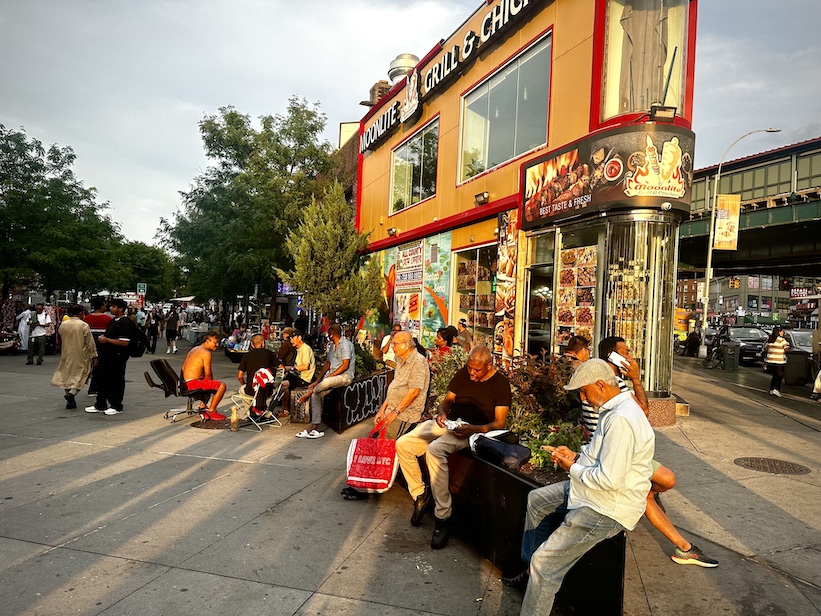
Jackson Height’s Diversity Plaza is located in New York City’s Borough of Queens. Photo by Ramaa Reddy
By Ramaa Reddy
Diversity Plaza, in Jackson Heights in the New York borough of Queens, is a landmark that celebrates the diversity of America.
In 2011, the city created the Plaza by cordoning off traffic and furnishing it with tables and chairs to provide South Asians inhabiting the multilingual neighborhood a space for families to meet, eat, and socialize. The area is lined with Bollywood posters, food stalls, Momo trucks, sweet Pan (beetle nut) shops, and apparel stands.
“People call this area little India as you can smell the curry on the street,” says Andrew Silverstein, co-owner of Streetwise New York Tours. “You can also call this little Pakistan, little Bangladesh, and more recently, little Tibet and little Nepal.”
It is not by accident that all these groups moved into the same area. They were following the lead of Indian immigrants who came in the 1970s, seeking their home-country ingredients and the need to communicate with other South Asians. The main drag of Jackson Heights is 74th Street, known as Kalpana Chawla Way since it commemorates the first Indian American astronaut who died, along with her seven crew members, in the 1997 Columbia Space Shuttle disaster. Gold jewelry shops and novel fashion trends in Indian couture grace the street alongside small storefront businesses opened by enterprising new immigrant families. To entice shoppers, men stand at storefront entrances offering special deals and palm readings.
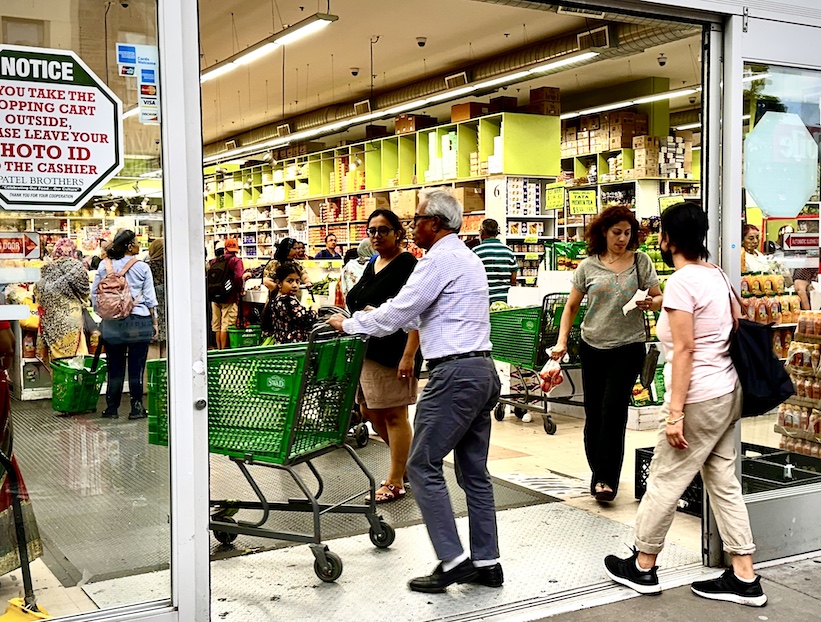
The Patel Brothers Food Store in Jackson Heights. Photo by Ramaa Reddy
A hallmark of the street is Patel Brothers, purveyors of unique South Asian foods. Opened in 1974, the Patel franchise owns around 65 supermarkets in the U.S., India, and Canada. They are known for their Indian vegetables which they source and import from Mexico, the Dominican Republic and different states in the US. For instance, unique vegetables like Flat Valore and Karela come from Florida; Tindora from the D.R.; and String Beans and Tuvar Long Beans from California. Annually, about 5000 containers of spices, lentils, and specialty items like Lays Masala Potato Chips are imported from India to satisfy the South Asian Palate.
The allure of Jackson Heights is its many delectable restaurants but three stand out for their excellence. The first is Kabab King, a 5-minute walk from Patels, and one of the oldest Pakistani restaurants in the neighborhood. Like its name, the seating area is royal with tables framed with ornately carved chairs. The food, especially the Goat Biryani – which bursts with the flavors of cardamom, coriander, and cinnamon – and the Kabab, and Chapati is reminiscent of India’s Mughal period.
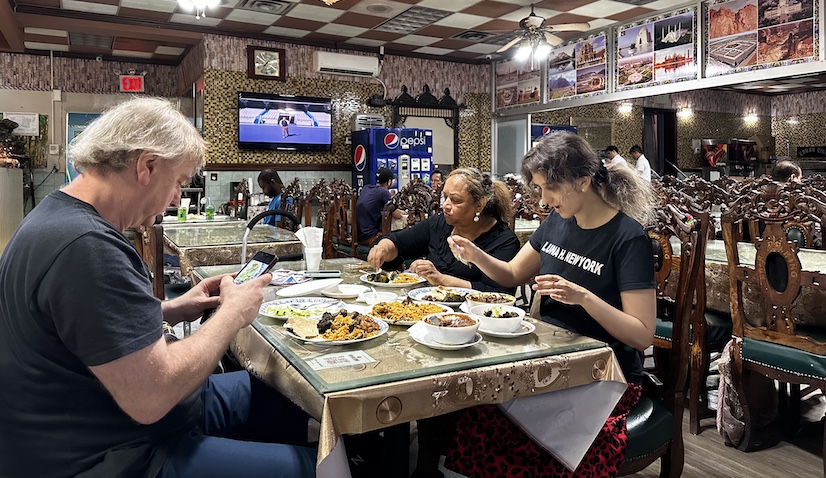
Customers enjoying a meal at Kabab King. Photo by Ramaa Reddy
From Kabab to Dosa
Another adjacent and not-to-be-missed establishment is Maharaja Sweets. Opened in 2000 by Sukhdev Bawa, the place is renowned for its chat – savory snacks that are often eaten roadside from stalls – and its confectionaries. Among the snacks, Dahi Puri stands out. It is a dish comprised of mini wheat flour shells stuffed with chickpeas and potatoes and garnished with yogurt, tamarind, cilantro chutney, and topped with crushed sev (crunchy deep-fried chickpea noodles). The combination of sweet and tangy alongside crunch is pure heaven! A nice finale to the meal is to try some sweets from the display case. The Malai Chumchum – made from condensed milk and cottage cheese – is their best seller. Annually, Bawa says he sells 1000 lbs. of this dessert. Equally enticing is the popular Gulab Jamun which are soft, springy balls made with dried milk solids and served warm in a rose-cardamom syrup.
A final eatery suggestion is the ever-popular Dosa Delight which is the home of the ubiquitous South Indian Dosa: a lentil paper crepe stuffed with potatoes and eaten with lentil soup and coconut chutney. The menu boasts of serving a variety of 31 dosas that range from plain to those filled with cheese or chocolate. The prices of these delectable foods are affordable to suit the wallets of students and those with limited budgets who are satisfying a craving for victuals from their home country.
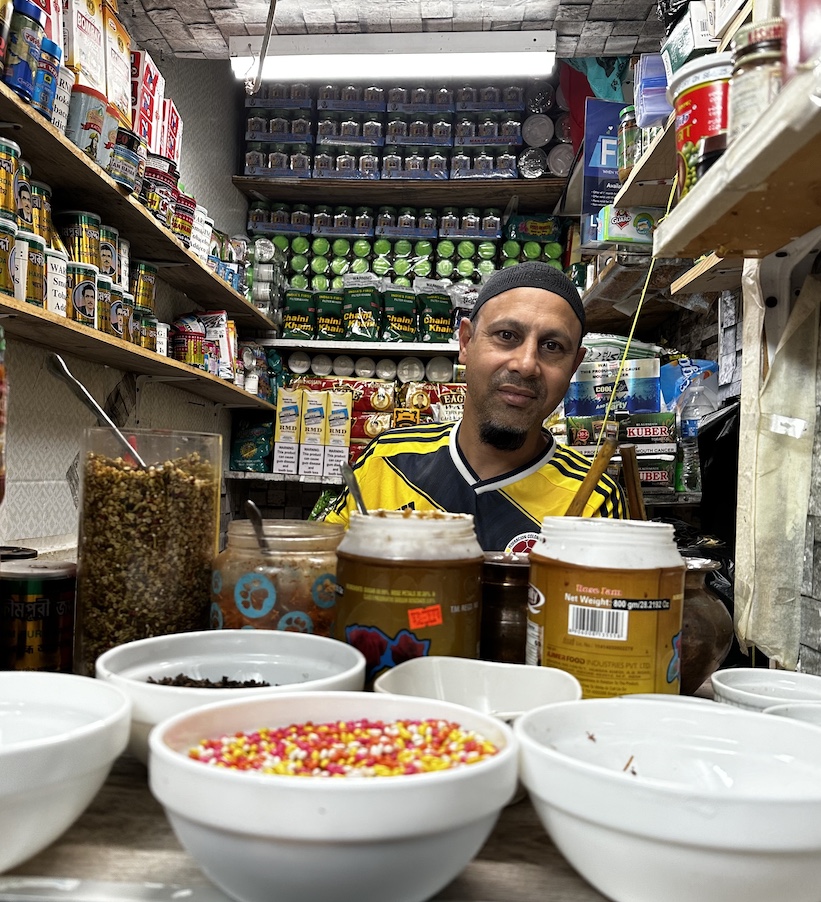
A vendor in his sweet Pan (beetle nut) shop. Photo by Ramaa Reddy copy
What’s Up With Cricket?
Alongside food is cricket; another popular South Asian import that has been gaining viewership and flavor among the American diaspora. This past June marked the first time that the ICC (International Cricket Club) World Cup 2024 competition was played with a homegrown American cricket team in Long Island’s new Nassau County International Stadium, which has a seating capacity of 34,000. Ticket prices for the sold-out India/Pakistan match ranged from $500-1000 a ticket! Credit for the increasing popularity of the sport goes to condensing its match time. For centuries cricket was played languidly over 5 days filled with brakes for hot tea and cucumber sandwiches. A shortened match that can be completed in just a few hours has gained popularity around the world.
On a recent humid, July afternoon Akram Chowdhury, a recent Indian American transplant and Uber driver, was playing cricket at Van Cortland Park, Bronx, home to eight cricket fields.
“I play the game every weekend because I love it and played it when I was a youngster in Bangladesh,” says Chowdhury
Many of the Jackson Heights establishments sell and advertise their merchandise on Google whose current CEO is Sundar Pichai. Like Pichai, many Indian Americans who are just 1.5% of the population are currently enjoying their moment in the spotlight on an ever-growing list of Indian American luminaries.
“They’re not only the highest-earning ethnic group but also occupy top positions at Microsoft, IBM, Adobe, and FedEx. They dominate the field in STEM and medicine,” says Shruti Rajgopalan.
Hotel Motel Patel
How did this come about and what is the trajectory of Indian immigration into America? According to Rajgopalan, between 1900 -1965, there were only a few thousand Indians of Indian origin living in the U.S. From 1980 -1994, the Family Unification Bill allowed individuals, like the above Patels, to sponsor their families into the U.S. not just for business opportunities but also to run motels. Interestingly, about 50% of US motel owners today are of Indian origin.
The IT Boomers arrived post-1995 and were engineers and STEM students.
Just before the Patels, between the years 1965-79, another cohort of Indians arrived. Classified as Early Movers these Indians were more accomplished in terms of education and skills.
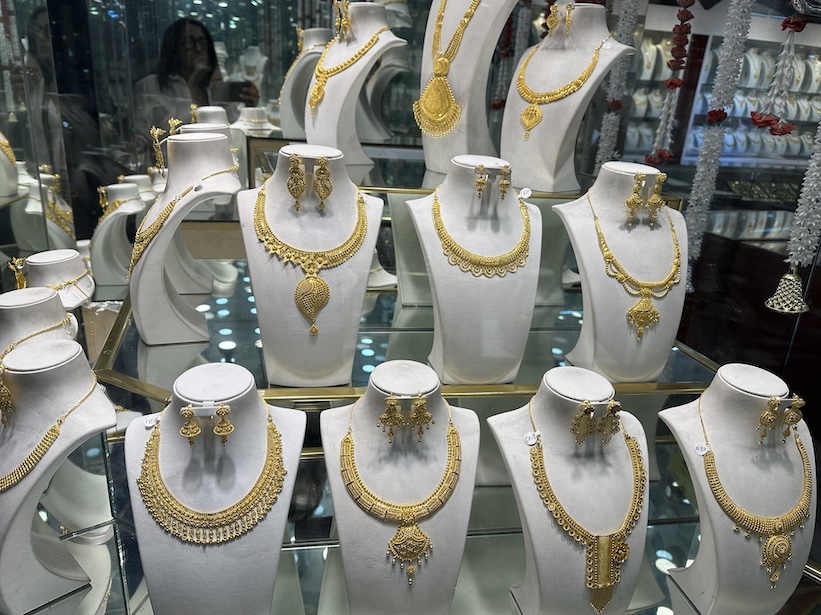
A store on 74th St. displays gold jewelry. Photo by Ramaa Reddy
Glass Ceiling Shattered
Rajgopalan’s explanation for the Indian success story is based on the ‘caste system’ that exists which prioritizes education above all else among its upper castes. This is true, but I believe that India’s history, of being a British colony helped tremendously as it embedded the English language into society enabling Indians to easily acclimatize to America’s language and culture. Today every family in India prioritizes education as they view it as a step toward success.
Rajgopalan continues to state that the 1980 census reported only 206,000 Indian immigrants in the U.S., and it is from this cohort that another category arose – politicians like Kamala Harris, Usha Vance, Nikki Haley, and Vivek Ramaswamy.
Today we stand at an interesting juncture in America’s political history. One of the two candidates of Indian origin will end up having the biggest job in the country, if not the world, and the other has the potential for future political success. Either way, one is bound to succeed.

Democratic Vice-President Kamala Devi Harris, 59, graduated from Howard University and the University of California Hastings College of Law after which she worked as the District Attorney of San Francisco and the Attorney General of California. In 2021, Harris was sworn into the U.S. Senate, and in 2021 became President Biden’s running mate. Last month, on July 21, President Joe Biden dropped out of the presidential race, endorsing Harris to be the next Democratic presidential nominee.
Usha Chilukuri Vance, 38, on the other hand, is the wife of JD Vance: Donald Trump’s Republican Vice-Presidential pick. Usha grew up in the suburbs of San Diego and is the child of academics – her mother is a marine molecular biologist and her father is an aerospace engineer and lecturer at San Diego State University. Usha excelled in academics and is a graduate of Yale Law School after which she clerked for Supreme Court Chief Justice John G. Roberts Jr. and Justice Brett Kavanaugh. After her marriage, she moved to San Francisco to work for a top corporate law firm.
Elegant Understatement
At the recently held Republican Convention, Usha brought a breath of fresh air to the event according to NYTimes fashion editor Vanessa Friedman, who described her as entering the event with little makeup, almost no eye shadow, and no visible lipstick.
“It was interesting to note that Usha does not hew to the specific mold of femininity that is the norm of the Trump world which involves heavy mascara (or false eyelashes), lip gloss, and vertiginous heels,” says Friedman.
Only time will tell how things pan out for these two who are traversing the novel and arduous path of politics. But as an immigrant arriving in this country in the 80s, I would never have envisioned that in 40 years Indians would be the captains of American industry and also would make a mark in American politics.
For now, I am basking in their success.
Ramaa Reddy lives in New York and is a graduate of the Columbia School of Journalism. Her previous stories for EWNS focused on Mexico’s San Miguel de Allende and the Jordanian city of Petra.

